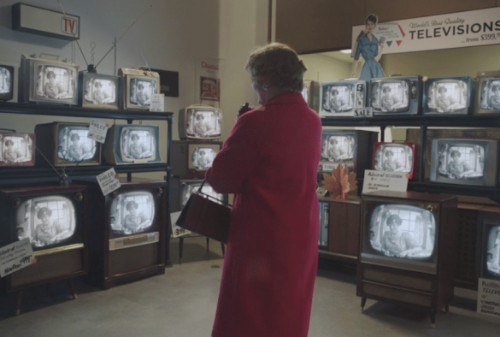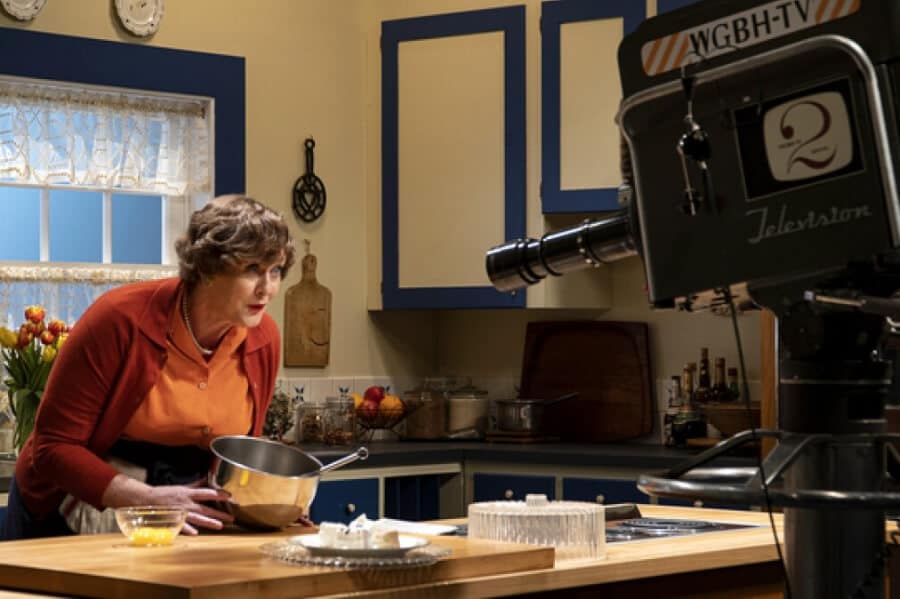Lately, the iconic chef Julia Child—who died in 2004—seems to be getting the pop cultural reverence that she deserves. It started with the 2009 release of the Nora Ephron movie Julie & Julia, in which the cooking giant was played by Meryl Streep.
But in the last year alone, the Julia revival has really heated up: we’ve gotten the documentary, Julia, made by the producers of RBG. A new Food Network show, The Julia Child Challenge, sends its winner to Paris to study at Le Cordon Bleu, Julia’s alma-mater.
Best of all, the not-so-creatively named Julia, a sparkling eight-episode series, started streaming on HBO Max earlier this month.
It picks up on her life after she and her Renaissance-man husband Paul return from France (and his dismissal from foreign service) to the U.S in the early 1960s, settling in Cambridge, Mass, just as the groundbreaking book that she had worked on for 12 years, Mastering the Art of French Cooking was published.
Author Barbara Lippert will be talking about new TV shows and movies at a special NextTribe Sunday Salon on May 15th. Free; members only. More information and sign up here.
As she readily admitted, Julia was neither French nor a chef (she called herself a home cook), and the book was co-written with two actual French chefs who were Julia’s friends. Even though it was “adapted” for an American audience, the authentic, from-scratch Gallic recipes were wildly complicated and exotic. Plus they were way more demanding, time-and-kitchen-skills-wise, than the meat loaf, Jell-O molds and even TV dinners that passed for American gastronomy at the time.
The series centers on how Julia elevated—and Frenchified—America’s tastebuds while becoming a beloved household name.
What I love most is the show’s focus: how a 6’2,” 51-year-old woman with no TV experience and a trilling, high-pitched voice that sounded like “the millionaire’s wife” on Gilligan’s Island, barreled onto the air at WGBH, the educational station in Boston, and revolutionized all the perceived notions about how to do, and what makes, great TV.
It was 1963, still a time when many women on commercial television were beauty queens pointing at refrigerators.
The series makes clear that at the then newly formed, shoestring operation WGBH, (which later became part of PBS) the all-male execs were determined to make high-minded educational content, to separate the station from “the vast wasteland” of established TV. With their Mad Men-style white shirts, black ties, and black glasses, they all pooh-poohed Julia’s idea. They were angry and frankly embarrassed to be associated with what they saw as such a trivial, womanly thing as a cooking show.
Read More: The Strange Mix on HBO’s Minx: Comedy, Feminism, and Dongs
Never Say No
But Julia never took “no”as an answer. The opening episode features Julia as a guest on a WGBH show about books, facing a comically pompous, dismissive academic host. Instead of discussing her cookbook, Julia decides to make an omelet on a hot plate on a coffee table on the set as they speak. The audience loves it, and it was there that she felt her calling came into focus in front of the cameras.
Julia Child is the ultimate inspiration—and founding mother—for female late-bloomers.
Julia shows how, with a unique combination of ebullience, confidence, and dog-with-a-bone persistence, she ignited a hugely successful 40-year multi-media career. In doing so, she became a living brand, (who never pushed brand name products) and the first person ever to win an Emmy for educational television.
But what never struck me until I watched this series is that Child, who didn’t learn to cook until age 40, and first appeared on TV at 51, is the ultimate inspiration—and founding mother—for female late-bloomers.
This was about five years before there was any traction for “women’s lib.” The early 1960s, in terms of gender roles, were still the rigid 1950s. So, the young, middle-class American housewives who Julia appealed to sadly had little idea how or where -or even whether -they were allowed to bloom.
Julia and Betty

In the earliest episodes of the series, we see how Julia and her producers, who had to borrow a kitchen at the local Boston Gas Company to shoot the show, essentially invented everything on-the-go, devising the-nuts-and-bolts of the genre, giving it the structure of a 3-act play, and paving the way for the foodie movement and the celebrity cooks and cooking shows that followed.
One of the funniest shots in the series is seeing how her team of at least five people sat on the floor, hiding behind her raised (for her height) kitchen counters, handing her spatulas or switched-out platters as she stood and spoke directly to the camera.
Even her famous sign-off, “This is Julia Child. Bon Appetit!” was done on-the-fly after a long day of shooting the pilot.
The first episode is frothy fun, like a mousse, and the show gets better, deeper, and richer as it goes along. I think some of Julia’s confidence came from the privilege she was born with, but she also had the talent, drive and a unique ability to connect with audiences.
By the second-to-last episode, (coming this week) we get a showdown between Betty Friedan, a founder of second-wave feminism whose Molotov cocktail of a book, The Feminine Mystique, was published in 1963, at exactly the same time that Julia’s TV career was exploding.
Child and Friedan—both Smith College graduates—were dealing in their own way with “the problem that has no name.”
Betty tells Julia that she’s not helping the women’s movement at all by tying women to the kitchen, taking two days to make crepe suzettes when they should be considering building outside careers.
This all sounds possible, and I can see that these women were two sides of the same coin, both Smith College graduates dealing in their own way with “the problem that has no name,” the restriction of being a wife and a mother with no real outlet for ambition or creativity.(The first episode also deals with Julia’s own sadness about menopause, and the realization that she’ll never have children, therefore throwing herself even more fiercely into her work.)
Ironically, both Betty and Julia came in for the same kind of criticism: that what they were doing appealed to educated, upper class women who had the time and money to complain, unlike the rest of the less privileged female population.
In Julia’s defense, she took cooking out of the kitchen because she made it part of the cultural conversation. With her riotous performances, she showed that women could have delicious fun in the kitchen, or choose to turn it into a competitive sport, or merely learn about really good food, rather than seeing meal-making as a chore.
For context, Friedan used to say that during the time she worked on her Mystique book, it was more acceptable in her suburban community to be an alcoholic than a writer.
Mistakes Were Made
Meanwhile, Julia, this show about a show, is created and co-produced by Daniel Goldfarb, who also worked on The Marvelous Mrs. Maisel. It shows. The production values and period costumes and detail have the same exquisite, nostalgia-inducing pixie dust as MMM, this time in a WASP-ified New England version. The acting is all-around marvelous too; the music is sprightly, and the dialogue is clever.
I had a problem sorting out history from fiction, however. For example, who knows if that showdown actually happened, but it sure makes for great drama.
An important thing that Julia modeled for her audience: not to be afraid of making mistakes.
Also, it’s a small detail, but Julia has Child saying that she footed the bill for the first few shows, even paying for the food. In real life, Julia has always maintained that she got “$50 an episode,” for the early versions of the show, before it was syndicated to other PBS stations, another pioneering concept that started with The French Chef. As the show develops, it shows that Julia has a gift for negotiation and dealing respectfully with her staff.
An important thing that Julia modeled for her audience: not to be afraid of making mistakes. This happened organically. In the early days, WGBH didn’t have the budget to edit, so the whole complicated process of compressing a four-hour dish into a 30-minute show had to be done in one live-on-tape take, with the inevitable flubs or errors left in.
In her funny, gracious way, she taught her students/viewers to embrace the idea that the souffle fell flat or that the chicken wing splattered to the floor, because it happens to everyone. She demonstrated how make the best of it, and since no one had to know, still serve the resulting dish with panache.
Part of her show’s comedy was that Julia liked to slap around, talk to, and play with her uncooked ingredients, particularly chicken and “big, old, ugly” vegetables. She was also naughty and flirty, saying things like “this is the best coq [pronounced like “cock”] I’ve ever had in my mouth.”
Relevance and Inside Jokes
I appreciate the inclusion of a Black character, Alice Naman, as Julia’s producer on the show, even though in real life she was white, Jewish, and a roommate of Child’s at Smith. (There were Black people working at WGBH at the time, although not as producers.) But as such, Alice stands alone, as the only Black cast member, and that’s too much weight to force on any single character. I struggled with that for the first few episodes, since the writers mostly focused on the sexism Alice faced as a woman, as did all of the white women working there. The question of race didn’t come up, even though racial equality was such a roiling issue in the larger world at the time.
We get more context for Alice as the episodes move on, but I think the writers missed a bigger opportunity for historical relevance. And by the way, I think Alice deserves her own future show.
Speaking of “relevance” that’s what the writers have Julia saying as she fights to get on the air. “I just want to feel relevant—to be relevant,” she says, which makes sense in the context but is not a phrase that someone in her milieu would have used in 1962.
Julia Child had an astonishing appetite for life and an ease in inspiring others to do the same.
One of the production’s better inside jokes is that Julia’s best friend, Avis DeVoto, is played by Bebe Neuworth, while Paul Child, the world’s most supportive husband, (although he didn’t want her doing TV at first, dismissing it as a “fad”) is played by David Hyde Pierce. For fans of Frasier, the fact that the two are often sniping at each other in Julia, just as they did previously as Niles and Lilith, is hysterical.
A word about Sarah Lancashire, the English actress who plays Julia. She was absolutely brilliant in Last Tango in Halifax and Happy Valley, and she brings her comic quickness to the role and lights up the screen as the larger-than-life doyenne of food.
Still, she is much more of a chubby, pink-cheeked English rose-type than Julia was, with a pretty, painted kewpie doll face that differs from Julia’s sportif tall girl look. At times, she doesn’t bother to hide her English accent, but it all rolls into the same exuberant, Franglais language that Julia speaks. And she’s terrific at embodying Julia’s joie de vivre—which the real Julia would no doubt have elongated into at least seven swooping syllables.
The Perfect Cameo
I also love the cameo by Isabella Rossellini as Simone “Simca” Beck, one of Julia’s French co-authors, who, like many serious French chefs, dramatically scorns all things American. Rossellini hams it up, looking like her mother, Ingrid Bergmann, when she played Golda Meir, which is a neat trick.
In reality, Julia Child had an astonishing appetite for life and an ease in inspiring others to do the same. With two more episodes to go, this series is high-toned and enjoyable, a worthy addition to the ever-growing Child canon.
It also made my mouth water at times, which sent me into my kitchen with the energy and determination to liven up my boring salad.
Bon Appetit!
Read More: Telling the Story of Women’s Rights, The Glorias Recharges Feminist Batteries





















0 Comments